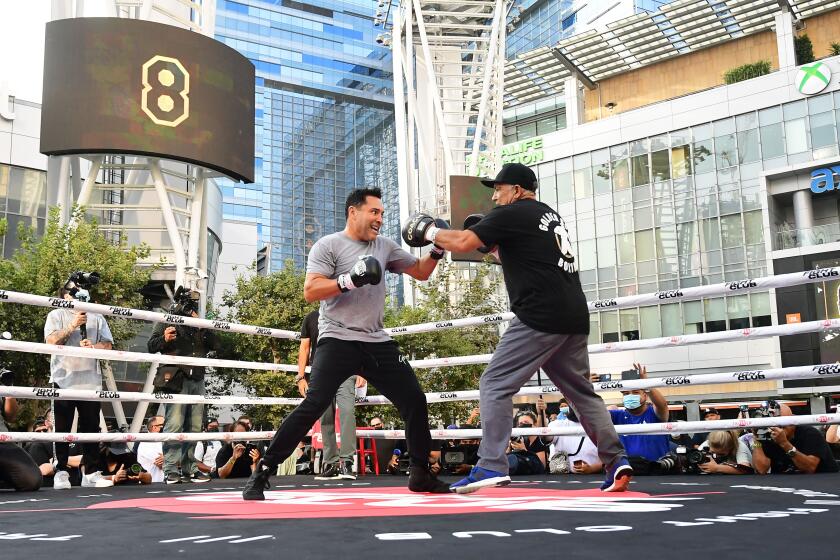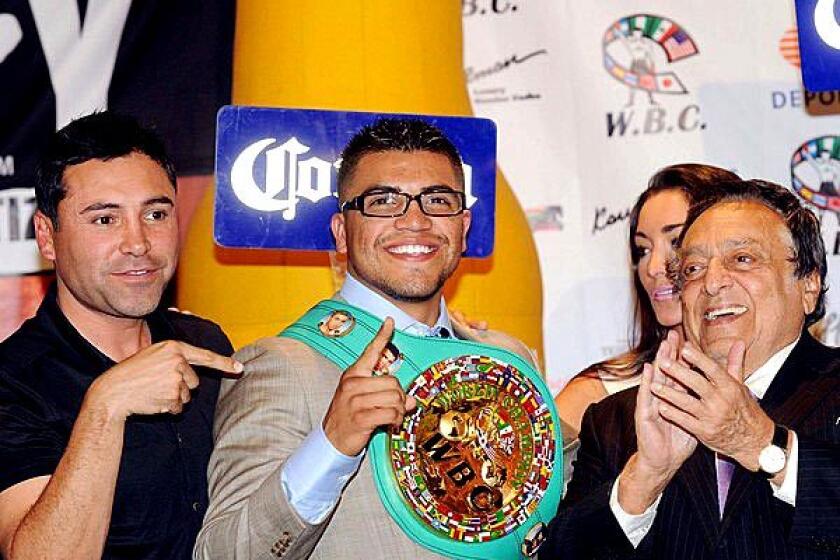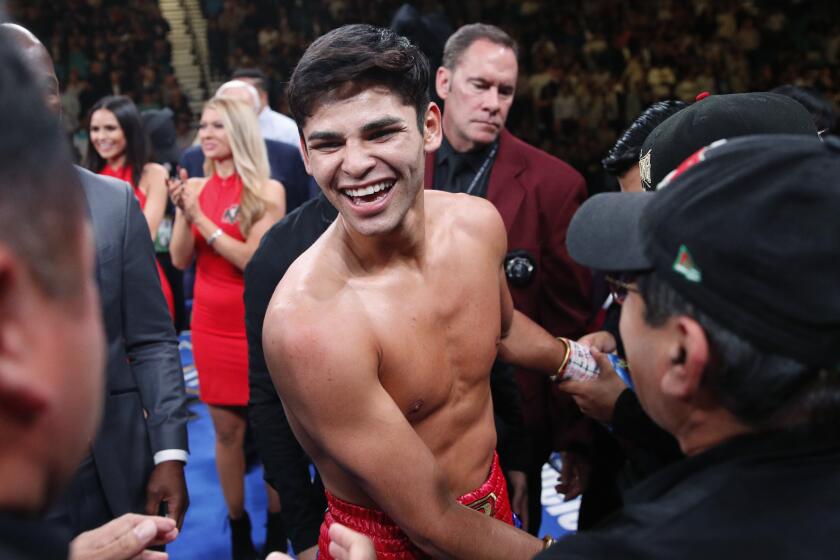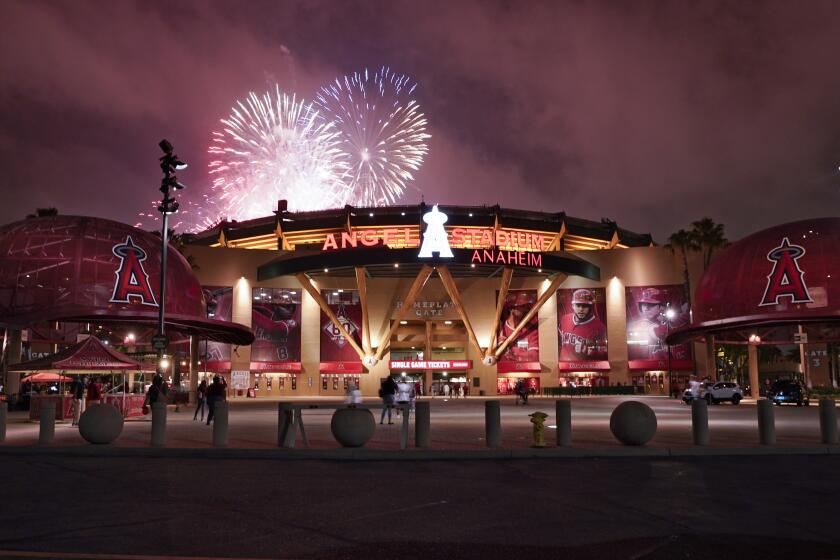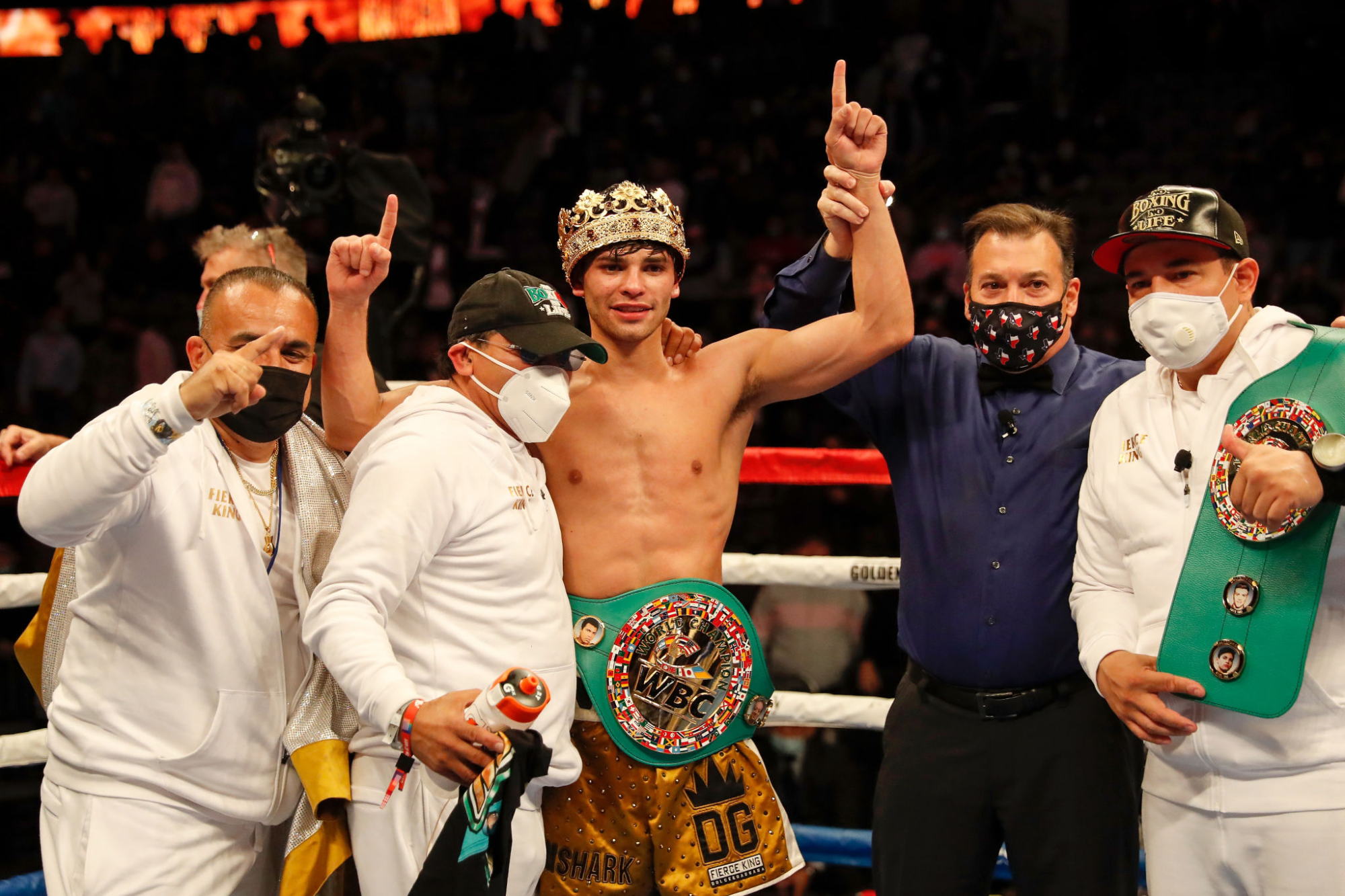
- Share via
These are different times in boxing, one of the sport’s most celebrated prospects talking about his mental health problems.
Could you imagine Joe Frazier opening up about something like that?
Roberto Duran no-mas’d more than 40 years ago and still hasn’t provided a convincing explanation for why he quit against Ray Leonard.
“Bottle it up, that’s how we did it, right?” Oscar De La Hoya said with a chuckle.
More than a decade removed from his days as a fighter, De La Hoya now promotes the up-and-coming boxer in question, Ryan Garcia of Victorville, who returns on Saturday night against Emmanuel Tagoe.
Ryan Garcia, a 22-year-old from Victorville, was knocked down but recovered to beat Luke Campbell. The rising star is not a finished product, though.
Garcia is 23, an age at which he should be fighting as often as possible. But the part-time model and social media influencer has already taken a 15-month sabbatical from the sport, withdrawing from one match last year to deal with what he described as crippling anxiety and another to recover from a hand injury.
“It was a hard year to endure with all the people talking their mess and having opinions on me and whatnot,” Garcia said. “But I think it’s going to be worth it one day.”
The question isn’t whether Garcia made the right call to sit out a year. He did. Step into a ring compromised and a fighter can quickly become an assault victim.
The question is what the meltdown says about Garcia’s future in the sport, whether the popular fighter has the makeup to be the De La Hoya of his time. The uncertainty has added an element of intrigue to an otherwise unremarkable fight against the wild-punching Tagoe.
“We don’t know how Ryan’s going to react,” De La Hoya said. “We don’t know, his head, where it’s going to be at.”
World-class fighters come in a wide range of shapes and sizes. Their styles are equally varied.
Done with repressing memories of a childhood sexual assault, Oscar De La Hoya is ready to fight Vitor Belfort and out for a win for himself.
What they have in common is an elevated level of resilience. Many of them are from impoverished backgrounds. They are constantly being asked for money by family members and friends. Their industry is often unfair and predatory. The work itself is punishing.
“This is the sport where you have to be tough, you can’t crack under pressure, you have to be a man, you have to just be mentally, physically tough and if you show any kinks in your armor, people are going to walk all over you,” De La Hoya said.
That’s how fighters used to think, at least.
Garcia has taken an innovative approach, revealing the kinds of vulnerabilities that boxers from previous generations kept secret until they were physically diminished, financially destitute and reduced to selling their sob stories.
“I couldn’t get my mind together,” Garcia said. “I couldn’t concentrate on anything. It was everywhere. I had panic attacks. I couldn’t help it. I was just panicking for no reason.”
That’s how Garcia described his mental state early last year, in the months after his most important win to date, a seventh-round stoppage of former world champion Luke Campbell.
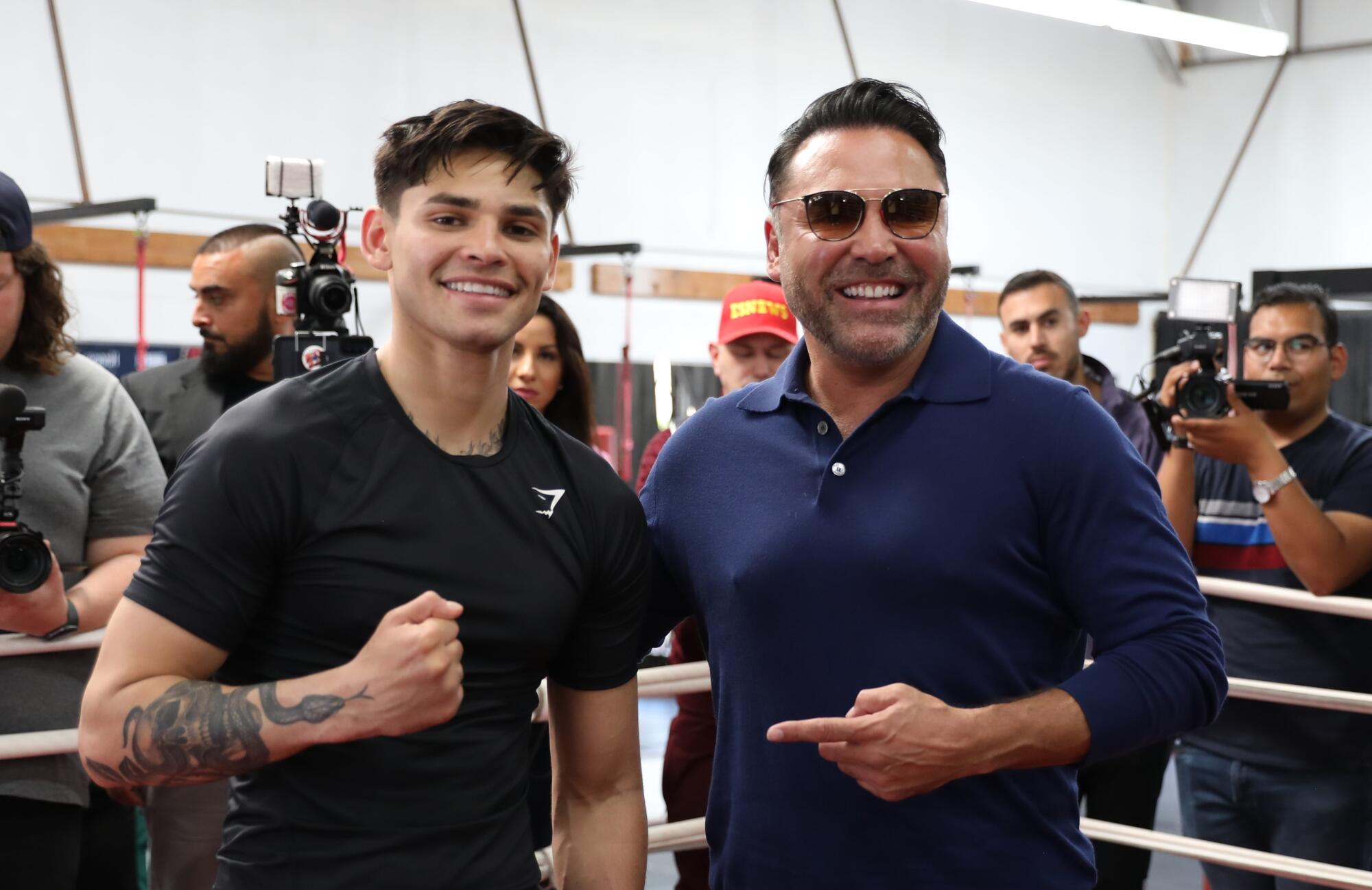
The victory established Garcia as a legitimate prospect instead of just a pretty face who figured out how to use social media to attract unusually large crowds. Garcia won the fight after recovering from a second-round knockdown, which showed he had the resolve of a champion but also the defense of a novice.
“People don’t look at him as just a fighter,” De La Hoya said. “That’s the pressure that he has on his back. He’s the next guy. He’s the pretty boy. He’s supposed to be carrying boxing on his shoulders after Canelo [Álvarez]. He’s young and he doesn’t have the experience. It’s a lot. I can’t imagine myself if social media was around.”
An Olympic gold medalist as an amateur, De La Hoya shouldered similar burdens when he was an active fighter. De La Hoya said he coped by becoming a substance abuser.
Garcia just shut down.
“It was affecting my everyday life,” Garcia said. “I felt like I couldn’t do anything. I was pretty tormented in my own mind. Words can’t really explain as well as, like, when you’re going through it. I felt very hopeless. At times, I didn’t feel like living.”
Garcia’s father, Henry, recalled his efforts to convince his son to train.
“When I would convince him, he would go, but then I would notice — who better than your dad? — I knew that he wasn’t 100%,” Henry said. “Ryan would just deliberately walk out.”
At the time, Garcia was working in Álvarez’s gym under Álvarez’s trainer, Eddy Reynoso. Henry said he tried explaining his son’s problems to Álvarez, but the Mexican champion nonetheless came to question the young fighter’s commitment.
“If somebody knows what you’re going through, instead of hitting him while he’s down, you should say, ‘Hey, man, we’re all family, let’s join together and let me help you,’ ” Henry said.
The significance of Canelo-Saunders might be getting lost in the hype around other gimmicky fights, but the matchup still holds substantial weight.
Garcia pulled out of a scheduled fight against former junior lightweight champion Javier Fortuna.
“I just needed to really take a step back because my anxiety was building up,” Garcia said. “Anybody who knows what anxiety actually is ... It’s not just like I’m nervous. It’s not that I’m nervous or I can’t fight, I’m scared. That wasn’t the issue. It was deeper than that.”
Garcia resumed training later in the year with an eye toward a November showdown with JoJo Diaz, only to suffer a hand injury that required surgery.
The mental-health break has made De La Hoya wonder whether Garcia has the necessary wiring to be a world-class fighter.
“Yeah, you ask yourself questions,” De La Hoya said.
Garcia is still in the developmental stages of his career in which he is beating up carefully selected opponents. If he’s stressed now, what will happen when the stakes are raised, when he starts taking on fighters who actually have a chance of beating him?
“I really think that on the contrary … this is going to really help him to really set the foundation and set the tone,” De La Hoya said. “If he uses it the right way, it can help him to have a solid foundation for other things that might arise when he does become world champion.”
The East LA native call it a career announcing his retirement from fighting in a press conference at L.A.
De La Hoya argued that what he did as a fighter — to suffer in silence, to “bottle it up” — is unhealthy.
“The right thing to do is what Ryan did,” he said. “You speak about it. You release it.”
That’s true for ordinary people. But if ordinary people were to deal with the waves of emotions boxers experience on fight week, they would think they were in the midst a mental health crises. In a sport this violent and brutal, isn’t it necessary to be able to suck it up the way De La Hoya did?
“I mean, look, I grew up in that era, where you do suck it up,” De La Hoya said. “But it didn’t turn out so well for me bottling it up.”
De La Hoya has continued dealing with substance-abuse problems in retirement. Then again, the reason he owns an office building in downtown Los Angeles is because of his success as a fighter. That success could be largely attributed to his ability to continue boxing at an elite level while he was emotionally tortured. And who is to say that resilience didn’t translate to resilience in the ring?
“As a fighter, it maybe did [help,]” De La Hoya conceded. “But, hey, we’re human as well.”
Ryan Garcia’s lightweight fight against Luke Campbell could be a litmus test for the 22-year-old rising star as he looks to challenge boxing’s stars.
There’s nothing wrong with a fighter prioritizing his long-term well-being. He just might want to consider another profession. Boxing isn’t for everyone.
Garcia said he never considered permanently walking away from the sport.
“I love boxing,” Garcia said. “Even though I’m going through all that s—, I was still competitive. I couldn’t watch a fight and not be like, ‘I’m going to beat his ass.’ That’s just in me. That’s who I am. You have to understand, you can’t kill that for nothing. That’s the last to go.”
He insisted his problems were unrelated to boxing.
De La Hoya was encouraged by the trainer Garcia chose after splitting with Reynoso this year. Garcia is working with renowned disciplinarian Joe Goossen, which De La Hoya interpreted as a symbol of Garcia’s ambition and commitment.
“The best thing about this is boxing is the most truthful sport in the game,” Garcia said.
At some point, the truth finds every fighter in the ring.
Garcia is counting on that truth to vindicate him, to prove that his moment of perceived weakness was, in fact, a moment of strength. He’d better be right. He’s not playing tennis. If he’s wrong, he won’t just be hurt emotionally. He’ll be wounded physically as well.
More to Read
Go beyond the scoreboard
Get the latest on L.A.'s teams in the daily Sports Report newsletter.
You may occasionally receive promotional content from the Los Angeles Times.


